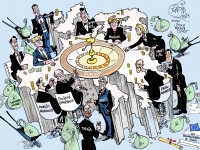EuroZone Profiteers: Welcome to the Casino

The impressive rise and sudden fall of the Greek, Irish and Spanish economies after they joined the EuroZone is often framed as a story of profligate governments and lazy citizens who spent too much and ended up deep in debt. The international community - notably the European Union (E.U.) - has been portrayed as a misguided group of bureaucrats who gave these foolish people billions to save them from their own recklessness and overspending.
But there's more to the story. There are lessons for everyone in understanding what happened in places like Spain and Ireland, for example, which have become the quintessential "canaries in the mineshaft" -- countries that did everything right, according the economic "experts," and yet still ended up flat on their backs. Greece too, to some extent, followed the economic policies dictated by conventional wisdom. Now it turns out that the experts were wrong, their metrics and measuring sticks often were measuring the wrong things, and when an unforeseen $8 trillion housing bubble in the United States collapsed, it spread around the world like a tsunami.
There has been much debate among economists on how the creation of the euro without supportive infrastructure like a banking union caused this crisis in Europe. This report will add to that discussion by analyzing the role of six specific banks that joined this roller coaster ride by helping to finance and promote the boom, only to be engulfed by it when the property bubble burst, first in the U.S. and then across the Atlantic.
In the end, these banks had to be rescued by their respective governments, damaging public balance sheets and resulting in indebted governments even in Ireland and Spain, which were running government surpluses with low debt before the EuroZone crisis. The banks that we chose represent a cross-section of institutions that helped trigger the crisis, although they are not necessarily the biggest banks nor the worst banks that took part in the boom and the bust. Our goal is to add to this dynamic debate by illustrating the public-private policy choices concerning the banking and finance sectors that, in total, nearly brought the EuroZone to the point of collapse.
For Europe, this economic crisis has been a wake-up call. The last few years has shown the limitations of an old economic model which, like in the U.S., relies on speculative asset bubbles which in turn leads to unsustainable private debt.
The Gamblers
Picture a fictitious EuroZone casino with a gambling table piled high with million-euro chips. Each chip represent a real mega-loan from a group of elite bankers in Belgium, France, Germany, the Netherlands, and the U.K. who, over the past dozen years during boom times, shoveled out money as fast as they could to borrowers in countries, including Greece, Ireland, and Spain.
Southern Europe is dotted with monuments to this frenzied lending. An airport in Castellón, in eastern Spain got a lavish loan in March 2006. It still has no planes, but it does feature a sculpture of Carlos Fabra, the regional politician who initiated the project.[1] A little digging shows the hand of Dexia Banco Sabadell, a Belgian-French bank that helped provide tens of millions of euros to build this architectural folly for which there still is no demand. And it wasn't the only foolish scheme. Regional banks and governments, which political parties in Spain historically had used to reward their local cronies with construction projects such as sports stadiums and "airports to nowhere," began to fail en masse when the bubble burst. It fell to the national government to take on these debts.
Or take the case of Georges Pauget, the CEO of Crédit Agricole in France, who bought up Emporiki Bank of Greece for â¬3.1 billion in cash in 2006. Over the next six years, Emporiki lost money year after year, blowing money on one foolish venture after another, until finally, Crédit Agricole sold it for â¬1 - not â¬1 billion or even â¬1 million - but a single euro to Alpha Bank in October 2012. Crédit Agricole's cumulative loss? â¬5.3 billion.[2]
Then there was Georg Funke, who ran Depfa, a German public mortgage bank. Depfa helped Athens get a star credit rating, raised â¬265 million for the Greek government railway, helped Portugal borrow â¬200 million to build up a water supplier, and gave â¬90 million to Spain to construct a privately operated road in Galicia. For a while, the middle class in Greece like the middle classes in Spain and Ireland, benefited from the infrastructure spending stimulus. When Depfa nearly collapsed in 2008, Funke was fired.[3]
These are just three examples of over-eager Belgian, French, and German banks that faced financial ruin after shoveling billions of euros for get-rich-quick schemes throughout Europe, investments in subprime mortgages in the U.S., as well as grandiose public schemes that were often abandoned half way through.
Today high stake rollers have moved into gamble on the debt created by the EuroZone crash. Dan Loeb of Third Point hedge fund scored $500 million gambling on Greek debt last December [4] while Achilles Risvas and Jason Manolopoulos run Dromeus Capital, another hedge fund that made millions this past January.[5]
Meanwhile,Andreas Vgenopoulos of Laiki Bank in Cyprus lost â¬3 billion buying discount Greek bonds with savings entrusted to him by faraway Russians.[6] These hedge funds and their exotic investment instruments such as derivatives and credit default swaps are supposed to be a means to help manage the risk of global capitalism. Instead, they have helped build a house of cards. When the house wobbled, entire national economies collapsed.
While the casino is imaginary, the power, profits, and losses are real. This report attempts to illuminate the individuals and institutions in the runaway banking elite that fed the loans that helped weaken the wobbly foundation of the EuroZone, eventually ending in crisis.
[1] Raphael Minder, "In Spain, a Symbol of Ruin at an Airport to Nowhere," New York Times, July 18, 2012. http://www.nytimes.com/2012/07/19/world/europe/in-spain-a-symbol-of-ruin-at-an-airport-to-nowhere.html
[2] Elisa Martinuzzi, Fabio Benedetti & Maria Petrakis, "Credit Agricole Gets Bids for Emporiki from Greece's Banks," Bloomberg, August 9, 2012.http://www.bloomberg.com/news/2012-08-08/credit-agricole-s-emporiki-gets-bids-from-greece-s-biggest-banks.html
[3] Jack Ewing, "Debtors' Prism: Who has Europe's Loans?," New York Times, June 5, 2010. and Derek Scally, "Former Irish Depfa directors may be sued by parent group," Irish Times, January 02, 2010. http://www.garp.org/risk-news-and-resources/risk-headlines/story.aspx?altTemplate=PrintYellowBrixStory&newsId=7147
[4] Louis Armitstead, "Dan Loeb's Third Point Hedge Fund Makes $500m Profit from Greek Bonds," Daily Telegraph (UK), December 19, 2012. http://www.telegraph.co.uk/finance/newsbysector/banksandfinance/9754460/Dan-Loebs-Third-Point-hedge-fund-makes-500m-profit-from-Greek-bonds.html
[5] Sam Jones, "Hedge Fund's Greek Gamble Pays Off," Financial Times, January 17, 2013. http://www.ft.com/intl/cms/s/0/fbb9f512-6099-11e2-a31a-00144feab49a.html
[6] Landon Thomas, "Calculating Impact of Cyprus's Bank Bailout," New York Times, March 31, 2013. http://www.nytimes.com/2013/04/01/business/global/calculating-impact-of-cypruss-bank-bailout.html
- 104 Globalization



